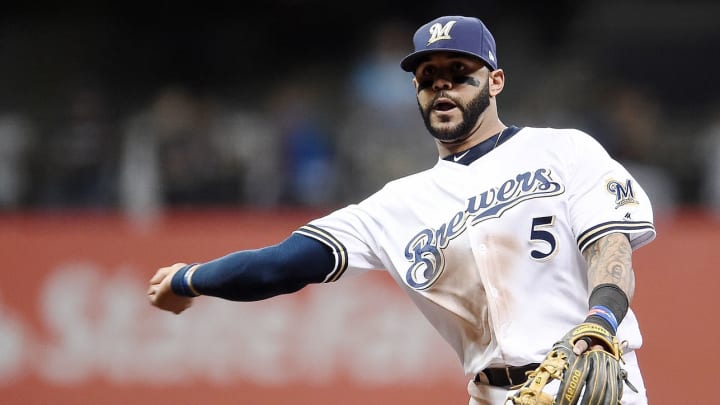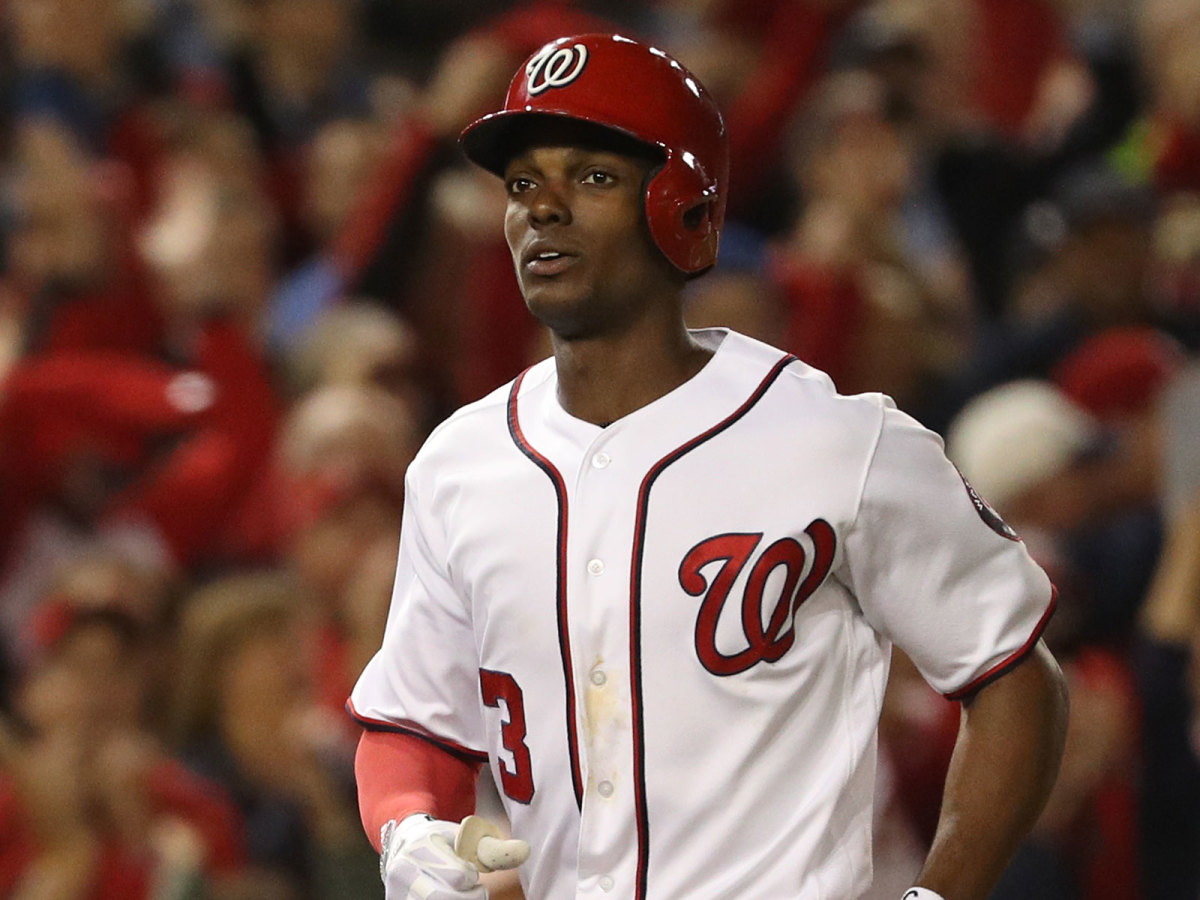Dinelson Lamet, Michael Taylor Among Top NL Fantasy Sleepers for 2018

The idea of a true sleeper is a relic of the past. In an effort to return one of the mainstays of the fantasy sports lexicon to its original meaning, we dug deep for our sleeper columns this year. Everyone in this column has an average draft position of 185 or lower. Pick No. 185 comes in the 16th round of a 12-team draft, 14th round of a 14-teamer, and 13th round of a 15-teamer. Most of the players herein are coming off the board much later than that. It may be harder than ever to find a true sleeper in fantasy leagues, but we won’t let that stop us from trying.
We’ve divided all of our sleepers, busts and breakouts columns, what we call our Staples Series, by league. In this installment of the Staples Series, we take a look at NL Sleepers.
Jonathan Villar, 2B, Brewers (ADP: 187.16)
I don’t want to sound like a jerk, but anyone who paid for Villar’s 2016 season in 2017 got what they deserved. The guy was essentially a replacement-level player for three years before exploding in 2016. His price tag the following year left almost no room for profit. He had to match what he did in his breakout season to justify the selection, and that’s bad practice for any player, let alone one who still had significant question marks. The ADP pendulum swung too far last year, but it has overcorrected this season. Villar is still going to play mostly every day in a potent Milwaukee lineup. Not only is a threat to steal 40 bases, but if he makes, say, 130 starts, it would be a disappointment if he fell short of that mark. He also does it from a position where most fantasy owners won’t mind employing a specialist. Villar is one of my favorite targets this season.
Jameson Taillon, SP, Pirates (ADP: 187.23)
The best news about Taillon is that he is cancer-free after his bout with testicular cancer last season. Fully healthy once again, a top-40 season feels almost like a layup. His ADP, however, doesn’t force you to pay for it. He may never be a strikeout-per-inning pitcher, but he keeps the ball on the ground and in the ballpark, which helps him limit damage on even his worst days. His walk rate surged to 7.8% last year, but it was 4.1% the previous season in about 30 fewer innings. That’s nothing to dismiss out of hand, but it’s likely the real Taillon is somewhere between those two numbers. Still just 26 with the pedigree of a former No. 2 overall pick and elite prospect, there’s also the chance that Taillon has another level in him. This is a perfect risk to take at this stage of your draft.
Austin Barnes, C, Dodgers (ADP: 205.44)
The trickiest part about believing in Barnes is that he might not draw the majority of the starts behind the plate for the Dodgers. Yasmani Grandal is still in Los Angeles, and he’s not likely to be reduced to a bench bat and pure backup catcher. Still, Dave Roberts favored Barnes in the Dodgers run to the World Series last year, and he has impressive on-base skills, especially for a late-round catcher. Barnes hit .289/.408/.486 in 262 plate appearances last year, notching a 14.9% walk rate. If he had enough plate appearances to qualify for the batting title, 14.9% would’ve been the sixth-highest walk rate in the majors. They payoff there alone is enough to take a shot on him at his price. If he distances himself from Grandal enough to be the clear starter for the Dodgers, he could be a top-10 catcher.
Dinelson Lamet, SP, Padres (ADP: 210.89)
Lamet is my favorite pick this season in the non-star division. I love everything about the Padres righty. I love that he’s just in his age-25 season. I love that, in his first taste of the majors last year, he racked up 139 strikeouts in 114 1/3 innings, to go with a strikeout rate of 28.7%. You know how many starters had a higher strikeout rate? Nine. They’re all pretty good: Chris Sale, Max Scherzer, Corey Kluber, Robbie Ray, Clayton Kershaw, Luis Severino, Chris Archer, Stephen Strasburg and Jacob deGrom. I love that his four-seamer sits in the mid-90s. I love that he throws a power slider that had a 19% whiff rate last season. I love that there’s real potential in his changeup, evidenced by its 15.5% whiff rate and 46.2% ground-ball rate. And, of course, I love that he’s only going to cost me an 18th-round pick in a 12-team league, and a 16th-round pick in a 14-teamer.
David Dahl, OF, Rockies (ADP: 229.23)
There’s a legitimate chance that Dahl is nothing more than a fourth outfielder this year. The Rockies seem intent on giving Ryan McMahon (more on him later) plenty of leash at first base, which pushes Ian Desmond to left field. Charlie Blackmon is locked in center, leaving a three-way competition in right among Dahl, Raimel Tapia and Gerardo Parra. The latter is likely out until Opening Day, if not longer, but Tapia is getting an opportunity to prove himself as a leadoff man. And yet, if Dahl can work his way into the starting lineup, there is a ton of potential here.
It was just two years ago that he hit .315/.359/.500 with seven homers in 237 plate appearances with the Rockies. That was after he belted 18 homers in 400 plate appearances across the top two levels of the minors before he got the call to Colorado. Injuries robbed him of the entire 2017 season, but there’s no question that he has significant pop. Dahl is an ideal low-risk, high-reward play at this price tag.

Michael Taylor, OF, Nationals (ADP: 237.12)
You aren’t going to find too many players with legitimate 20-20 potential at any point of your draft, let alone at pick Nos. 235 through 240. Taylor hit 19 homers and stole 17 bases last year, and he did it in just 432 plate appearances. Now that he has a line on an everyday gig, as well as about 550 plate appearances, 20-20 is well within reach. If everything breaks his way, 25-25 could be in the equation. He’s going to hit toward the bottom of the order, but slotting behind Bryce Harper, Daniel Murphy, Anthony Rendon and Ryan Zimmerman should give him plenty of RBI opportunities. He still strikes out way too much, but his speed makes him the sort of player capable of posting above-average BABIP. A .270/.320/.480 line with 20 homers, 20 steals, 70 RBI and 60 runs is in play.
Tyler Chatwood, SP, Cubs (ADP: 267.71)
It may have been the slowest offseason since Curt Flood and Marvin Miller changed the game, but the Cubs acted fast on Chatwood. Take a look at his stuff and some of his non-surface stats, and it’s easy to see why. Chatwood is a fastball-sinker-slider-curveball pitcher, who sits in the mid-90s with the first two offerings. He’s also an extreme ground-ball pitcher, posting a 58.1% ground-ball rate last year. That should play quite nicely with the Cubs' elite infield defense behind him.
Chatwood was the latest victim of Coors Field, but he showed what he could do when the Rockies went on the road. He pitched to a 3.49 ERA and 1.23 WHIP with 62 strikeouts in 77 1/3 innings away from Coors last season. Couple that with the significant improvement he’ll get in his infield defense, and there’s top-40 starting pitcher upside here. The one major drawback is his control. Chatwood has posted double-digit walk rates the last two seasons, peaking at 12.2% last year. That’s a huge problem, no matter where you play. If he can harness his stuff, however, he could make a significant leap this season.
Jose Martinez, OF, Cardinals (ADP: 278.09)
Last season may have been the tipping point of the launch angle revolution, with home run total spiking across the league, but don’t let that cloud your judgment of Martinez. He looked like a new man last year, hitting .309/.379/.518 with 14 homers in 307 plate appearances. The changes in his approach are obvious. Go back over his entire minor league career, which began in 2008, and you’ll find primarily a ground-ball hitter. Martinez posted a ground-ball rate of less than 50% at one stop before 2016. It was High-A ball with the Braves in 2014—when he was in his age-25 season—and his ground-ball rate was 49.5%. He joins the Cardinals organization in 2016, cuts his ground-ball rate to 42.1% at Triple-A Memphis, forces his way to the majors the next season, keeps his ground-ball rate at that same 42.1%, and suddenly finds his power stroke. That’s substantive change in which the fantasy community can believe, and the market doesn’t force you to pay for it at all.
Josh Hader, RP, Brewers (ADP: 294.1)
Hader will start the season in the bullpen, and fantasy owners may actually want him to stay there all season. In our relief pitcher primer, I wrote about how the shifting sands of bullpen management across the league have changed the way fantasy owners should attack the position. Put simply, fantasy owners can create an SP2/3 type by pairing two high-inning, high-strikeout, low-rate relievers. Hader can be one end of a 2018 Montvenski (named for Mike Montgomery of the Cubs and Chris Devenski of the Astros, the prototypes for this brand of reliever). He’s a great target for savvy fantasy owners late in drafts, no matter your league’s format.
Ryan McMahon, 1B, Rockies (ADP: 318.73)
McMahon spent most of 2017 split between Double-A Hartford and Triple-A Albuquerque, smacking 20 homers in 519 plate appearances. He slashed .326/.390/.536 with Hartford, and then stepped up his game at the next level, hitting .374/.411/.612 at Albuquerque. The 23-year-old has strong hit and power tools, and will have every opportunity to win and hold the starting first base gig for the Rockies this season. Forget about the growing pains attendant to any rookie not named Mike Trout. His skill set, opportunity and price tag make him an easy player to target in fantasy leagues.
